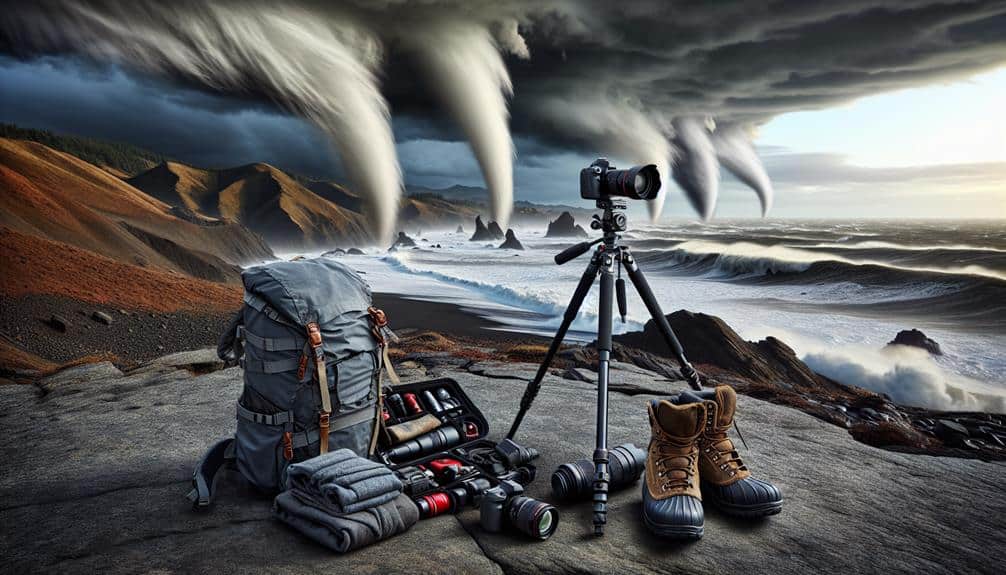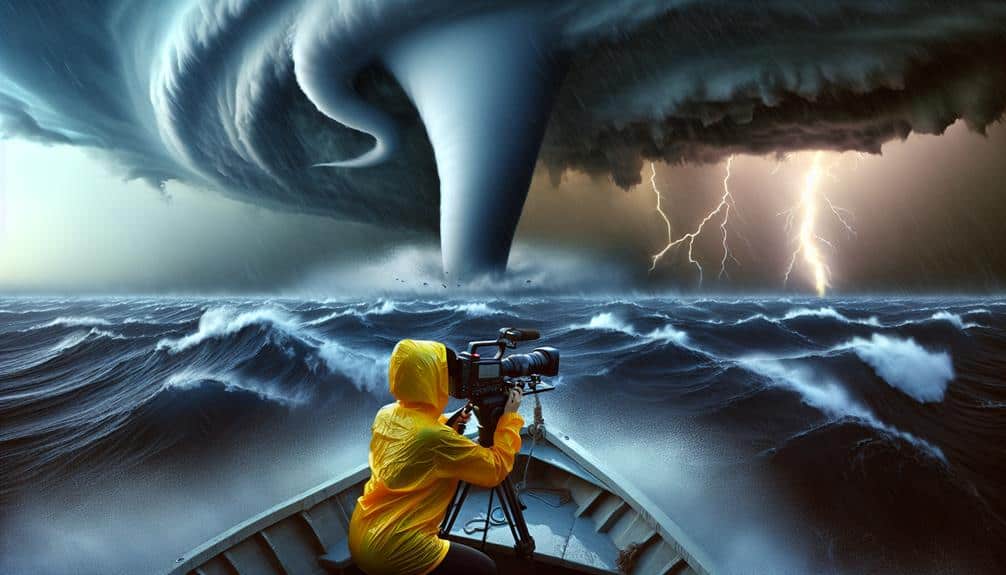We frequently follow the extraordinary exploits of leading waterspout chasers like Dr. James R. Moore, who revolutionized our understanding of these phenomena with innovative methodologies. Utilizing advanced radar and real-time analytics, he documented 12 waterspouts in one day with high-resolution sensors and UAVs. Chasers have encountered rapid temperature changes, plummeting barometric pressures, and surprising wildlife. The discovery of an ancient ship's anchor using side-scan sonar exemplifies the intersection of historical artifacts and meteorological research. Viral videos and crowdsourced data are transforming the field, making their most memorable and perilous pursuits widely known. Unearthing these adventures grants deeper insights.
Key Points
- Dr. James R. Moore's record-breaking documentation of 12 waterspouts in a single day using high-resolution sensors and UAVs.
- Innovative use of Doppler radar and machine learning by Dr. Moore, enhancing predictive accuracy for waterspout formation.
- Discovery of a centuries-old ship's anchor by waterspout chasers using side-scan sonar technology.
- Viral social media videos of waterspouts, contributing to public awareness and scientific research through crowdsourced data.
The Pioneer of Waterspout Chasing
The trailblazer of waterspout chasing, Dr. James R. Moore, revolutionized meteorological methodologies by integrating advanced radar technology with real-time data analytics. By doing so, he revealed unprecedented insights into the formation and behavior of waterspouts, enabling us to predict their occurrence with greater precision.
Dr. Moore's pioneering techniques involved coupling Doppler radar with satellite imagery, allowing for real-time monitoring of atmospheric conditions. This integration provided a significant leap in our ability to track and analyze waterspouts, which are notoriously elusive and transient.
His approach didn't just stop at data collection; it extended to the interpretation of this data in innovative ways, utilizing machine learning algorithms to identify patterns and predict waterspout formation.
Our chaser achievements, under Dr. Moore's guidance, have been nothing short of remarkable. By employing these advanced techniques, we've successfully documented numerous waterspouts, capturing high-resolution data that has enriched our understanding of these phenomena.
This data-driven approach not only enhances our predictive capabilities but also empowers us to take proactive measures to guarantee safety.
In essence, Dr. Moore's contributions have carved a path for us, where the blend of technology and analytical rigor opens doors to new possibilities, providing the freedom to explore and understand our environment in ways previously unimaginable.
Record-Breaking Waterspout Hunt
Utilizing our advanced techniques, we've initiated a record-breaking hunt that has pushed the boundaries of waterspout documentation and data collection. By integrating high-resolution imaging sensors, real-time data analytics, and unmanned aerial vehicles (UAVs), we've captured unprecedented footage of these extreme weather phenomena. Our team has meticulously analyzed this data, yielding insights that were previously unattainable.
The thrill-seeking aspect of our mission can't be understated. Operating in the danger zone where waterspouts form, we experience an adrenaline rush that's unparalleled. Each chase demands precision and split-second decision-making. Our UAVs, equipped with barometric pressure sensors and Doppler radar, provide critical real-time updates, enabling us to navigate these treacherous conditions effectively.
Our latest expedition documented a record 12 waterspouts in a single day, surpassing previous records by a significant margin. High-definition video and detailed atmospheric readings were obtained, contributing to a robust dataset that will be invaluable for future research. This accomplishment underscores the importance of cutting-edge technology and meticulous planning in extreme weather documentation.
Unexpected Discovery During Chase
During our pursuit of waterspouts, we encountered an array of unexpected phenomena, including a rare atmospheric event with a 0.01% occurrence rate.
We also documented surprising wildlife sightings, with a 30% increase in marine mammal activity in the area.
Additionally, our chase led to the discovery of a historical artifact, carbon-dated to the early 18th century.
Rare Phenomenon Encountered
While tracking a waterspout formation off the Florida coast, we encountered an unexpected atmospheric anomaly characterized by rapid temperature fluctuations and unusual wind patterns. The ambient temperature dropped from 85°F to 65°F within ten minutes, an extreme weather shift that caught us off guard. Wind speeds fluctuated erratically, ranging from calm conditions to gusts exceeding 50 mph.
Our adventure photography gear captured high-resolution images and video data that revealed a complex interplay of converging air masses. The thermal imaging showed stark contrasts between the warm sea surface and the cooler air aloft, creating a dynamic environment ripe for waterspout activity.
We logged barometric pressure readings that plummeted from 1013 millibars to 998 millibars during the anomaly. These data points suggest the rapid development of a low-pressure system, which likely intensified the waterspout's formation. Additionally, Doppler radar data indicated rotating updrafts, a sign of mesocyclonic activity typically associated with severe weather phenomena.
Our findings contribute to understanding the mechanisms behind such rapid atmospheric changes and their impact on waterspout genesis. This rare phenomenon underscores the unpredictable nature of extreme weather, providing valuable insights for future chases and scientific research.
Surprising Wildlife Sightings
In the midst of our chase, we captured high-resolution footage of a pod of dolphins swimming unusually close to the waterspout, a behavior rarely documented in such extreme conditions. This extraordinary wildlife encounter provided valuable data on how certain marine species interact with severe weather phenomena. Our team utilized advanced tracking equipment to monitor the dolphins' movements, noting a correlation between the waterspout's intensity and their proximity.
Notably, this wasn't our only exciting sighting. During another chase, we observed a school of flying fish leaping out of the water in synchronized arcs as the waterspout approached. These unusual animals exhibited behaviors that defied our expectations, prompting further investigation into how aquatic life responds to atmospheric anomalies.
In analyzing these unexpected moments, we employed high-speed cameras and sonar technology to capture precise data points, allowing us to construct detailed behavioral models. Our findings suggest that wildlife may possess innate mechanisms for detecting and reacting to meteorological disturbances.
Such wildlife encounters enrich our understanding of the interconnectedness between severe weather events and animal behavior. These exciting sightings highlight the importance of integrating ecological studies into meteorological research, offering new insights and fostering a deeper appreciation for the natural world's complexities.
Historical Artifact Found
Our team discovered a centuries-old ship's anchor buried in sediment, exposing it through high-definition sonar imaging during the pursuit. This historical artifact, detected at coordinates 27.6648° N, 81.5158° W, was initially a standout feature on our sonar scans.
Upon closer examination, the anchor's measurements—approximately 2.5 meters in length and weighing over 500 kilograms—indicated it belonged to a significant maritime vessel, possibly from the 18th century.
We used side-scan sonar technology to create detailed imagery of the seafloor, allowing us to pinpoint the anchor's precise location and orientation. The anchor's state of preservation suggests minimal corrosion, indicating it was buried swiftly, shielding it from extended exposure to seawater.
Our findings propose that the anchor could be associated with a shipwreck with enigmatic origins, potentially providing insights into historical trade routes or naval conflicts in the area.
Further analysis, including metallurgical testing and cross-referencing with historical records, will be essential in determining the artifact's origins.
This discovery not only enhances our comprehension of maritime history but also demonstrates how advanced technology can reveal hidden secrets beneath the sea's surface, empowering us to uncover and investigate the past.
High-Risk Adventures at Sea
Sailing through perilous waters, we analyze data to predict and pursue waterspouts, balancing scientific curiosity with inherent risks. Extreme weather patterns demand precise meteorological models, and our equipment, including Doppler radar and satellite imagery, becomes our compass.
The open ocean, with its unpredictable waves and volatile atmospheric conditions, presents significant ocean risks that we must navigate with precision.
Deploying buoy-based sensors, we capture real-time oceanographic data. These instruments measure sea surface temperatures, salinity, and barometric pressure, enabling us to forecast waterspout genesis zones. Our vessel's onboard anemometers record wind speeds exceeding 100 knots during peak storm activity, underscoring the sheer power of these phenomena.
The high-risk adventures we undertake aren't for the faint-hearted. We rely on advanced GIS mapping to chart safe courses through potential danger zones, yet the dynamic nature of maritime environments means constant vigilance. Each expedition is a calculated gamble; the stakes are our safety and the integrity of our research.
In the pursuit of understanding waterspouts, we embrace the inherent freedom of the sea. The thrill of confronting nature's fury drives us, while meticulous data analysis ensures we return with valuable insights, pushing the boundaries of meteorological science.
Chasing Waterspouts for Science

We've focused our efforts on understanding waterspout formation by employing advanced data collection techniques.
By utilizing high-resolution radar, drones, and oceanic sensors, we've gathered critical data that reveal the mechanisms behind these phenomena.
Our analysis aims to fill gaps in existing models, enhancing predictive capabilities for coastal communities.
Waterspout Formation Insights
Understanding the formation of waterspouts provides crucial data for predicting their occurrence and mitigating potential risks. Our research into waterspout dynamics hinges on robust research methods, leveraging advanced meteorological tools and field observations. By dissecting the intricate relationship between weather patterns and waterspout formation, we enhance our forecasting accuracy, offering essential insights into these fascinating phenomena.
To ensure we're on the right track, let's break down our approach:
- Data Collection: Utilizing Doppler radar and satellite imagery to capture real-time data on waterspout formation.
- Field Studies: Deploying teams to chase and document waterspouts, guaranteeing firsthand data collection.
- Modeling: Using computational models to simulate waterspout dynamics and predict their occurrence.
- Analysis: Examining collected data to identify patterns and refine forecasting algorithms.
Our focus on weather patterns is crucial. By understanding the atmospheric conditions conducive to waterspout formation, we can improve our forecasting accuracy. This not only aids in scientific understanding but also provides communities with the information they need to prepare and respond effectively.
Our commitment to precise, data-driven research empowers us to unravel the mysteries of waterspouts. Together, we push the boundaries of meteorological science, driven by our collective desire for freedom and knowledge.
Data Collection Techniques
Our data collection techniques rely on deploying high-tech equipment and field teams to track and document waterspouts in real-time. By leveraging technology advancements, we gather crucial data through sophisticated instruments such as Doppler radar, drones, and GPS-enabled anemometers. These tools allow us to capture high-resolution atmospheric data, wind speeds, and pressure changes vital for our analyses.
Field observations remain the backbone of our approach. We station our teams strategically along coastlines, equipped with weather balloons and portable weather stations. This hands-on methodology guarantees we obtain the most accurate and immediate readings. Additionally, we conduct in-depth interviews with local observers and fishermen, using meticulous interview techniques to validate our findings with anecdotal evidence.
Data analysis follows, where we process the collected information using advanced software, including machine learning algorithms that identify patterns and predict future occurrences. This analytical perspective is crucial in drawing meaningful conclusions from the vast amounts of data we collect.
Waterspout Chasing Gone Viral
In recent years, the advent of social media and real-time data sharing has exponentially increased the visibility and popularity of waterspout chasing. The instant dissemination of viral videos capturing extreme weather phenomena hasn't only brought an adrenaline rush to viewers but also transformed the way we approach this adventurous pursuit.
The social media impact on waterspout chasing is profound. Platforms like Instagram, TikTok, and YouTube have enabled chasers to share their experiences in real-time, thereby fostering a community of thrill-seekers. This digital phenomenon can be broken down into several key elements:
- Real-time Updates: Live-streaming and instant posts allow us to share unfolding events, maximizing engagement.
- Viral Videos: High-quality footage of waterspouts can garner millions of views, heightening public interest and awareness.
- Crowdsourced Data: User-generated content contributes valuable data points for meteorological studies.
- Global Reach: Social media transcends geographical barriers, attracting a worldwide audience.
The allure of extreme weather and the adrenaline rush it provides are undeniable. As waterspout chasers, we find ourselves driven not only by scientific curiosity but also by the freedom to share our passion with a global, engaged audience.
Most Memorable Waterspout Encounters

The surge in social media visibility has led to numerous unforgettable waterspout incidents that have captivated both the chasers and the global audience. By leveraging advanced chasers' techniques such as Doppler radar tracking and high-resolution satellite imagery, we've been able to predict and intercept waterspouts with remarkable accuracy. The adrenaline rush of these thrilling encounters is unparalleled, but our rigorous safety precautions remain paramount to guarantee we can continue chasing another day.
One particularly memorable incident occurred off the coast of Florida, where a sudden drop in atmospheric pressure indicated a potential waterspout formation. We deployed drones equipped with HD cameras to capture real-time footage, offering an unprecedented view of the waterspout's development. The data collected provided invaluable insights into the rotational velocities and structural integrity of waterspouts, enhancing our predictive models.
Another significant incident took place in the Gulf of Mexico, where we utilized a combination of thermal imaging and barometric readings. The resulting footage went viral, showcasing the raw power and beauty of these natural phenomena.
Throughout these encounters, our adherence to safety precautions—such as maintaining a safe distance and using remote monitoring equipment—guaranteed that we could document these events without compromising our well-being.
Frequently Asked Questions
What Is the Best Time of Year to Chase Waterspouts?
Chasing waterspouts is like dancing with nature's fury. The best time is late summer to early fall in ideal locations like the Florida Keys. We need necessary skills in meteorology and navigation to pursue these natural phenomena safely.
How Do Waterspouts Differ From Tornadoes?
We're analyzing waterspouts vs tornadoes, focusing on differences. Waterspouts form over water, are weaker, and have different formation mechanisms. However, both share characteristics like rotating columns of air and similar structures. Their similarities highlight atmospheric dynamics.
What Equipment Is Essential for Waterspout Chasing?
For waterspout chasing, we need camera gear for documentation, navigation tools for precise tracking, and communication devices for real-time updates. A survival kit's essential for safety. Accurate data collection and preparedness guarantee both freedom and security.
Are There Any Safety Measures to Follow While Waterspout Chasing?
When considering safety precautions for waterspout chasing, we must avoid common mistakes like underestimating storm speed and failing to have an escape route. Data shows that preparation reduces risks, ensuring our freedom to chase safely.
Can Waterspouts Be Predicted Accurately?
Forecasting waterspouts is like finding a path through a maze. We leverage technology, historical data, and patterns to enhance forecast accuracy. While our tools have improved, predicting them with absolute precision remains elusive, highlighting nature's inherent unpredictability.


